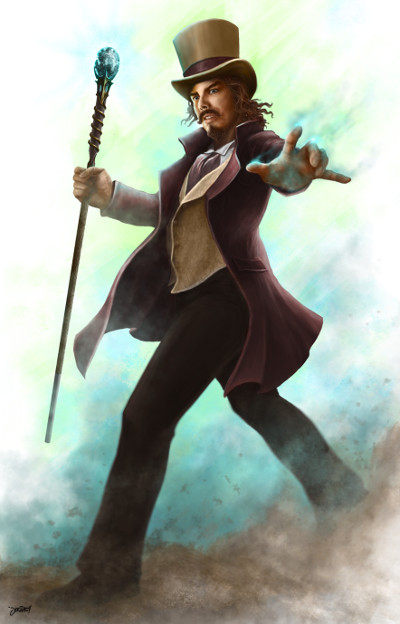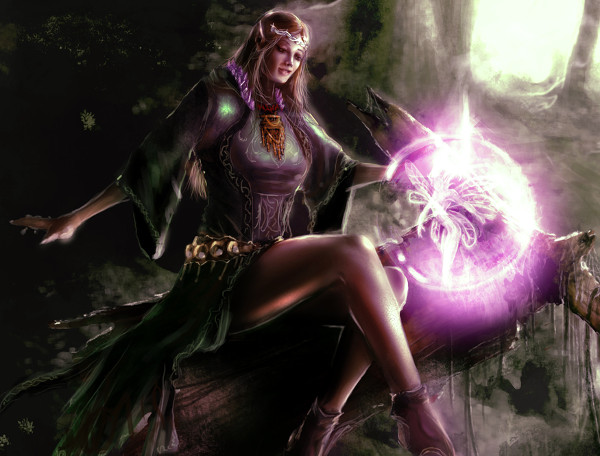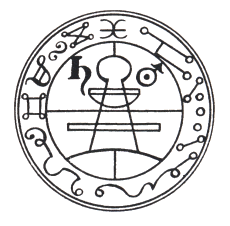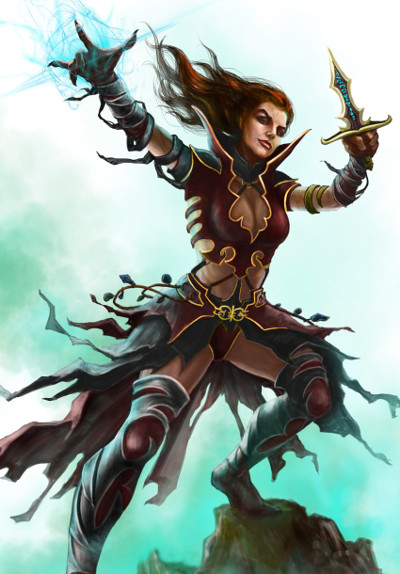By composing chords of aetheric resonance, mages and other practitioners can generate an almost limitless number of empowerments. These empowerment (colloquially termed “spells”) are broadly grouped by their general effect, and these are cataloged below. Keep in mind, however, that there are many other ways to group and classify empowerments, and there are no hard and fast rules regarding what empowerment falls into what grouping.
Warding
Wards are barriers that shield or protect against specific thing: energy, kinetic, elemental, scrying/sensing, visibility, necrolic, light, explosions, bullets, and so on. The more specific the ward, the stronger it protects against that thing. But wards work both ways, whatever they ward against can no more exit the ward than they can enter the ward. There are ways around that limitation, and practitioners can create a “keyhole” to send something through, although they must be careful as something could pass in through the keyhole as well.
A kinetic ward is a barrier of energy capable of blocking or deflecting kinetic force, physical attacks, or fast-moving objects within a specific range of force or speed. An energy ward is a barrier of energy capable of blocking or deflecting most energy-based attacks of a certain power or greater. Aetheric wards can blocking or deflecting most magical energy attacks, but do not protect from kinetic attacks or non-magical energy attacks (like normal fire or natural lightning).
In addition to the these, there are many other kinds of wards, including various elemental wards, spirit wards, scrying wards, momentum wards, locking wards, and countless others.
Projection
Projections are projected empowerments, such as beams, bolts, lances, bursts, waves, and so forth. They are typically used for attacks, but could serve other purposes as well.
The most common type of projection empowerment are a projected energy attacks, which generally takes the form of a beam, bolt, lance, orb, ball, or so-called bolide, which is like a fireball composed of aetheric energy. Shock waves, concussive blasts, and other burst of kinetic force also fall under the category of projection empowerments.
Apart from attacks, projection also includes all forms of kinetic manipulation, such as moving or levitating objects at a distance, as well as imparting acceleration to a person or object, or deceleration. A skilled mage, sorcerer, or theurgist can use projection empowerments for telekinetic effects, or to suddenly accelerate themselves or someone else in one direction. Likewise, projection empowermetns can also be used to decelerate, allowing for a quick stop, or to safely break a fall.
Augmentation
Augmentation empowerments, also commonly called blessings when performed by theurgists, are empowerments that bestow a positive aetheric resonance on an individual, on an item, or across a wide area. Countless prayers and entreaties exist that bestow such positive aetheric resonance, and the possible range of their effects is almost limitless. Some simply bring feelings of warmth and contentment, while others can be used to give inspiration, or instill great joy and exhilaration—even rapture and ecstasy. Other blessings can be used to endow a warrior with greater strength, higher agility, or faster speed than normal, or may even enhance his ability to withstand pain and injury on the battlefield. Still other augmentations might enhance the senses, giving better sight or hearing, or may bolster one’s competence in a particular skill for a time.
Beyond augmentations and blessings are “boons”, also known as benedictions or greater blessings. These are effectively the same as augmentations or blessings, but are either far more powerful, augment a greater range of abilities, or lasts considerably longer (days or weeks instead of hours). They are also typically invoked as part of a long and elaborate ceremony. Unlike Maledictions, benedictions cannot be permanent, and the reason why is simply due to the law of entropy–it is far easier to destroy than it is to create or enhance, and a malediction that ravages the body can inflict permanent damage.
Debilitation
Debilitation empowerments, also commonly called curses when used for evil or when performed by a karcist or evil theurgist, are empowerments that inflict a negative aetheric resonance on an individual, on an item, or across a wide area. The simplest debilitation empowerments simply instill some negative emotion, such as fear or sorrow, or may be used to cause a distracting head pain. Other debilitations may reduce physical and mental abilities, such as making someone physically weak or sluggish, impairing their mental faculties, inducing temporary blindness or deafness (or reducing the quality of the senses), and similar negative effects.
Beyond debilitations and curses are maledictions, also known as greater curses. The most common maledictions are those that inflict long-lasting pain, either to a specific part of the body, or to the entire body. Other maledictions are used to inflict disability, such as to weaken muscles, cause nervous shakes, or induce blindness or deafness. Other, more elaborate maledictions may inflict a physical malady, such as a wasting disease, festering pox, sores that never heal, or unceasing vomiting and sickness. Maledictions can also be used to wither limbs, inflict paralysis, or render a victim horrible disfigured. What makes maledictions particularly insidious is the fact that, if not cured within a few weeks, the effect becomes permanent. A complex benediction ritual is needed to lift a malediction, but they are not always successful. Depending on the damage caused by the curse, certain healing spells might also help.

Illusions
Mages are well known for their skill at crafting elaborate illusions and conjuring fully materialized objects “out of thin air.” Illusions are typically composed of chords of vibration, light, and form, twisting and shaping the light to create a visual illusion. Illusions can have a sound component as well. They are not physical, so objects can pass right through them, and poorly created ones can be seen to be obviously artificial.
Illusions can be created by focusing magical energies in order to create tricks of light and sound by using immaterial aetheric forms projected into the physical world. Such illusions can be small, such as an illusion of a coin, or so astoundingly expansive as to create an entire illusory landscape that is complete with sounds and smells. How small, how great, and how detailed the illusion is all depend on the amount of energy applied and the skill of the practitioner conjuring the illusion.
Conjury
Conjury covers those empowerments concerned with the direct manipulation of matter and energy. Technically speaking, anyone who can use magic can manipulate energy, and conducting aethergy is the most basic form of conjury. Beyond this, mages and sorcerers are able to directly control and manipulate a wide range of “physical” energies, that is to say, electrical energy, moment energy (momentum), the energy of alchemical bonds, thermal (heat) energy, light energy, kinetic energy, vibration energy, and aetheric energy (aethergy) and metaplasmic energy (the “materialize” form of aethergy). Elementors, of course, can conjure and control elemental energy and matter.
In manipulating such energies, mages, sorcerers, and elementors can create a very wide range of effects, including all forms of kinetic manipulation (covered under Projection), electrical manipulation (covered under Elemental), manipulating heat and temperature, breaking down compounds or enhancing alchemical reactions, as well as manipulating light, sound, aethergy, and metaplasm to generate illusions and metaplasmic conjurations (see Illusions).
Material conjury concerns allows mages, sorcerers, and elementors to shape, distort, or otherwise alter the physical appearance and physical properties of matter. The general shape and appearance of objects and items can be altered, allowing swords or daggers to be lengthened, clothes to be shrunk or expanded, the balance of dice to be subtly altered, and the composition of glassware to become suddenly liquid.
Healing
There is no question that the greatest benefit of spirit magic comes in the form of healing, renewing, and curing. The vitalic resonance is one of life and spiritual focus, and it generally falls under the wider domain of spirit magic. However, only those who dedicate themselves to the arts of life and spiritual magic can master the great art of healing, curing, soothing, and mending. Mages, elementors, and sorcerers have almost no proficiency in the healing arts as compared to theurgists and shamans (although sorcerers may know some, if they received training from a shaman).
It must always be remembered that magic is not the end-all, cure-all of every pain, malady, or injury. Although there are innumerable spells and curatives different diseases and poisons, there is no cure-all empowerment for every disease and malady. Magic can also be used to mend broken bones and severe physical trauma, but such empowerments are difficult and can only be perform by the most skilled healers. While stories abound of spells that can regenerate lost limbs, such spells are now lost, if they ever really existed to begin with. Certain restoration spells can cure blindness, but magic can do nothing if the eyes themselves are destroyed. Nor can healing spells remove bullets, arrowheads, or shrapnel from the body. Healing is impossible to perform until the bullet or other foreign material is removed from the wound. As powerful as magic may be, field medicine, surgery, and natural recovery are just as important—if not more so.
Primal

Primal magic, which may also be called natural magic or shamanic magic, encompasses those spells and rituals concerned with plants and animals, growing things, sensing weather and the environment, and bringing oneself into closer kinship with the natural world. These empowerments also include the ability to summon and control animals, and even to communicate with animals (to a limited degree).
Shamans and others who practice the arts of primal and natural magic can exert some degree of control over animals both great and small, including beasts that are normally considered monstrous. Although the ability to call and control animals is a quintessential ability of all shamans and Eldren, the techniques are actually quite difficult to master and can take years of training and dedicated practice. The shaman must learn how to extend his will upon the ever-flowing resonance of nature, what mages would call the currents of the aether, exerting his mental control over beasts. While it is impossible to control intelligent creatures in this way, shamans can invoke spells both to call and control wolves, bears, wildcats, and even such things as dire wolves, dire boars, and sabertooths. It is also possible for shamans to call and control monstrous beasts such as trugs, tarsks, basilisks, bulgores, and grimclaws. Of course, should the shaman’s control over these monstrous creatures ever waver, he would find himself in grave peril.
Elemental
Elemental magery covers all empowerments used to invoke particular powers, qualities, or forces related to the nine elements of nature—earth, stone, water, air, fire, thunder, light, lightning, and aether. Elemental empowerments are most widely employed by elementors, shaman, and Eldren, but most mages and sorcerers know a fair number of elemental empowerments as well.
Elemental magery is generally grouped into material and energetic elements, the material elements being earth, stone, water, and air, while the energetic elements are fire, thunder, light, and lightning. Aether is generally excluded as an element when dealing purely with elemental resonance, being that aether is not so much an element in and of itself, but rather, is the spatial medium of the aether. What is meant by aether as an element is actually aethergy, and aethergy is used to fuel all empowerments. In this sense, all magic employs the element of aether.

It is no surprise that the most popular forms of elemental resonance revolve around fire. As a result, there are more fire related empowerments than all the other elementals empowerments combined. Virtually all mages learn some control over light, enabling them to create orbs of pure light or to illuminate entire rooms with light pervading every corner, nook, and cranny. The element of lightning is chiefly used for its obvious destructive potential, while thunder is concerned with empowerments that harness the reverberating force of thunder itself, as well as sound and vibration in general. The element of air can be used to call wind to push ships at great speed or to conjure ferocious storms; water can be used to project a sudden blast of water, or to extinguish flames; earth is often used to shape earth, creating walls and barriers, or sudden pits and snares, as well as ground shaking earthquakes; and empowerments involving the element of stone are actually focused on the shaping and manipulation of metals, as well as the powerful force of magnetism.
Most elementors also learn the art of summoning elemental spirits and creating elemental constructs. This topic is discussed in more detail under the subject of Summoning.
Disruption

Disruption empowerments are used to disrupt, dispel, scatter, or otherwise negate other empowerments and various forms of energy. The simplest of these are a class of empowerments simply concerned with concealing magic. Concealment spells are quite common, and are often used on empowered items, magical devices, and on mages themselves, to conceal an otherwise detectable magical aura. Used on an empowered item or device, that item will appear non-magical, and if used on a person, that person will not appear to possess any magical abilities. A more advanced form of conceal magic, generally known as an aetheric cloak, provides the same benefit as conceal magic and also shields against all forms of scrying and magical detection, including aetheric sight, detection and tracking empowerments, remote viewing, and other forms of delving and extra-sensory perception.
A more focused application of disruptive magic are dispellments. Dispellments, as the name implies, are used to dispel the effects of other spells, disrupting their patterns with an injection of random aetheric disorder. Most empowerments can be dispelled in this manner, however, dispellments are generally considered to be quick, crude, and imprecise. True aetheric countermeasures are much more effective than dispellments and are exactingly precise in combating opposing empowerments. Whereas dispellments are like a sledgehammer, countermeasures are more akin to a surgeon’s scalpel. Like a surgeon with his scalpel, the disruptor mage must know exactly what empowerment he is countering and how to counter it. If successful, the counter-harmonic dissonance will cancel out the other empowerment, essentially switching it off with no appreciable effects. However, countermeasures are notoriously difficult to pull off—especially in the fire-blazing, lightning-cracking, thunder-blasting chaos of a battle between mages.
Perception
Perception empowerments are used to sense, detect, see, taste, touch, hear, delve, or scry. Sensing and detecting are simpler, in that they impart only a general “sense”, whereas more advanced perception techniques are analogous to actually seeing, hearing, and touching at a distance.
Practically all mages, theurgists, sorcerers, and shamans learn to detect magic as one of their earliest and most basic abilities. This innate “always on” form detect magic lets practitioners sense vibrations in the aether, alerting them to any active empowerments that are nearby. Similar to detect magic is aetheric sight, which enables a practitioner to see the aetheric pattern of empowerments as they are being perform, as well as aetheric entities such as ghosts, specters, and egregores, and incidentally, to see many other things that are normally invisible.
Clairvoyance and scrying are empowerments that allow a practitioner to see what would normally be out of sight. Looking into a room, the clairvoyant may get a general sense of its layout and the objects inside and can focus on individual objects to envision them in greater detail. Scrying allows the sorcerer, mystic, or psychurgist to see over a much greater distance using a scrying ball or other aid. Mages prefer the empowerment known as “the all-seeing eye,” which summons a simple egregore that can send back images of everything it sees as it flies invisibly through the aether.
Delvings include those empowerments that allow the practitioner to search or scan an object for some key information, imprint, or residual impression. Delving is basically a complex form of forensic analysis, and can take minutes to hours of intense focus, comprehensive study, and dedicated effort. The end result is either the information that was being sought, or the knowledge that such information is simply not present, or that the evidence has been altered or tampered with. Delving empowerments are among the primary tools used by detective mages.
Telepathy
Telepathy covers those various techniques used for telepathic communication and information gathering. Although telepathy is largely outside the domain of magery, these techniques are commonly employed by psychurgists. There are empowerments that replicate the effects of telepathy, but most are strictly consider psychic phenomena.
Telepathy is, of course, most closely associated with the telepathic transmission and reception of words, images, and thoughts. Telepathic messages can be focused and propagated through the aether to a specific individual (if that individual is well known to the sender), or to all nearby individuals.
The ability to read the minds of others is another well-known telepathic technique, although it can only be performed by skilled psychurgists. For mind reading to even be possible, the psychurgist must also be sufficiently competent with a range of telepathic techniques. The most basic form of mind reading is the ability to sense emotions and detect lies. A more advanced form is direct scanning. Direct scanning of another person’s mind is a more forceful search through a subject’s mind for specific thoughts, memory, or knowledge. Such intrusive mental scans can be felt and likewise resisted; empowerments and mental techniques can be used to erect powerful mental barriers that block such scans, and to shield one’s surface thoughts.
Shadow (Necrolic)
Shadow empowerments, also referred to as Necrolic empowerments, are those empowerments that are concerned with conjuring and controlling the undead, various necrolic attacks and curses, harnessing dark energies, and summoning malicious spirits. Shadow empowerments are the domain of karcists, dark sorcerers, and evil priests who use necrolic energy to corrupt and control spiritual forces to their own evil ends.
Maledictions are among the most common empowerments in a karcist’s repertoire of sinister sorceries. The sorts of curses and maledictions used by karcists are unsurprisingly the most agonizing and horrific that can be imagined, and are often utterly crippling in effect. Many such curses are of a necrolic nature, inflicting putrid rot and pestilent disease within the victim, or withering his limbs and muscles to useless waste
Karcists are perhaps most notorious for their empowerments used to infuse corpses with reanimating necrolic energy, bringing them “back to life” as mindless mortifant thralls. Mortifants will obey their master, although they are only capable of understanding basic commands such as where to go, where to stand, or what to attack.
Being practitioners of spiritual magic, karcists are capable of performing healing spells, but most karcists focus on undead healing. Also known as remortification, undead healing allows karcists to heal damage to mortifants and other undead (including vampires), as well as themselves. Healing a living creature with remortification does work, but replaces the damaged tissue with undead tissue. Missing limbs can be remortified in the same way, and this is perhaps the only means to magically restore a missing limb.
Karcists are also quite versed in the summoning of spirits—usually malicious phantoms or wraiths, or any lesser spirit that the karcist can twist to his dark will. See the section on Summoning for more information.
Summoning

Most elementors—and mages, to one extent or another—learn the art of summoning elemental spirits and creating elemental constructs. After having perfected the empowerments in a particular sphere of elemental magery, the elementor or mage may move on to mastering those spells used to summon the aetheric spirits that embody the elemental forces. Elementors can also create elemental constructs. Although elementals constructs appear to be similar to elemental spirits, they are artificial elementals more similar to egregores than actual spirits. Elemental constructs are created out of pure elemental resonance and are usually assembled from nearby rubble, debris, or other materials.
Just as elementors can summon elemental spirits and shamans can summon beast spirits, adepts of spirit magic can summon spirits such as specters, phantoms, wraiths, and ancestral spirits. Apparitions and specters have little will of their own and can be easily subjugated by sorcerers to do their bidding. Phantoms, wraiths, revenants, and, to some degree, ancestral spirits are far more powerful and willful beings; only the most skilled sorcerers can control these spirits once they have been summoned.
Egrigore Automata
Although mages can summon and control elemental spirits, they generally prefer to create their own artificial aetheric constructs known more commonly as egregores. Such creations are far more predictable and easier to control than elementals and other kinds of spirits, but there are among the most difficult empowerments to compose.
Watchdog egregore can be used to monitor a door, chest, or safe. If it is opened, the egregore may then sound an audible alarm, telepathically alert the mage who created it, or compose an empowerment the mage has instilled it with. Such watchdog egregores are used for many other purposes, as well, and can wait silently for days, weeks, or even months on end for a particular condition, event, intruder, or individual before carrying out its singular instruction.
Seeker egregores are designed to travel through the aether, seeking a target or searching for a particular person, on a mission as benign as delivering a message or as nefarious as executing a brutal assassination. Guardian egregores can protect from egregore spies and assassins. Practically every king, duke, baron, or merchant prince is surrounded by guardian egregores conjured by his most trusted mages.
Highly specialized egregores can also be created, and such egregores may be designed to record events or information, transcribe text, translate languages directly into the listener’s mind, perform feats of encryption and decipherment, maintain and regulate complex astral empowerments, or create disruptive anti-magic fields in the aetheric currents. The possibilities for their use are truly endless, and the ability to create and control egregores is the greatest tool any mage will ever possess.
For information on conductor egregore, please see the section on Aetheric Conductors.
Aetheric Conductors
Conductor empowerments allow a mage or other practitioner to create a kind of “aethergy-pump,” drawing ambient aethergy into a talisman, vizstone, or device. Although this is similar to what practitioners can already do (all practitioners can draw ambient aethergy) the conductor empowerment will work independent of the practitioner, drawing a continuous flow into whatever item it is linked to. Infused within a vizstone, the conductor empowerment makes the vizstone a powerstone, which will continuously draw a small trickle of aethergy.
Although elementors summon elementals for numerous tasks, among the most common is to serve as a conductor elemental. These conductor elementals hover behind or above the elementor, providing their summoner with a continuous flow of elementally-charged aethergy. That aethergy, however, can only be used to power elemental empowerments of the same elemental type. As a result, elementors may summon two or three different elemental conductors, or simply focus on one specific set of elemental empowerments.
Conductor spirits include both animal spirits, phantasmal spirits, and ancestor spirits, depending on what type the summoner is most familiar with. These spirits are more willful than elemental spirits, and thus require more focus and control on the part of the shaman or spiritor. However, the aethergy provided by the spirit can be used to fuel any kind of empowerment.
Conductor egregores are typically used by mages and sorcerers. Conductor egregores are more like aetheric machines than spirits, able to conduct multiple streams of aethergy and direct the currents into several empowerments simultaneously. Mages may also create self-sustaining egregores that incorporate their own conductor empowerments, allowing them to carry out various tasks over a longer period of time.